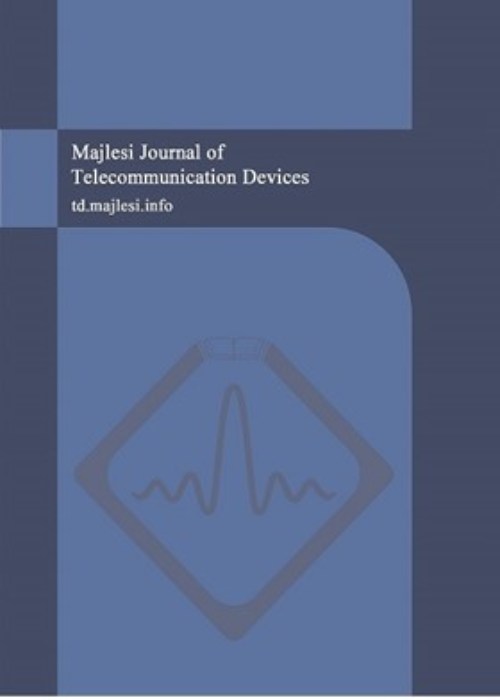فهرست مطالب
Majlesi Journal of Telecommunication Devices
Volume:1 Issue: 2, Jun 2012
- تاریخ انتشار: 1391/04/08
- تعداد عناوین: 7
-
Pages 39-43In recent years, there has been a growing interest in wireless sensor networks. One of the major issues in wireless sensor network is developing an energy-efficient clustering protocol. The hot point in these algorithms is the cluster head selection. In this paper, we study the impact of heterogeneity of nodes in terms of their energy in wireless sensor networks that are hierarchically clustered. Adapting this approach, we introduce energy efficient to cope with energy heterogeneity among sensor nodes; a modified clustering algorithm is proposed with a three-tier sensor node (SEP-E) setting. Finally, the simulation results for MATLAB demonstrate that our proposed heterogeneous clustering approach is more effective in prolonging the network lifetime compared with LEACH.
-
Pages 44-47This study is concentrated on the use of health care apps among smartphone subscribers in Tehran1. These apps are divided to 3 categories; Pharmacological applications, Dream meanings applications and Diet applications.. The survey method with sample of 384 students is administered in this paper. Analysis of the findings indicates that there is a significant relationship between gender and different types of healthcare apps which subscribers use on their smartphones.
-
Pages 48-52Detection of the range spread target in high resolution radar (HRR) is studied and a novel method based on scattering centers with high entropy in complex white noise is proposed. The proposed detector uses two-threshold strategy. The first threshold determines high entropy centers of the target then, these centers are used in a GLRT test to decide about presence of target. It is shown that the proposed detector can estimate the variance of background noise so it exhibits a CFAR property.
-
Pages 53-58Nowadays image meshing has a large number of usages in multitude research and medical areas. In this article two gradient bases and one element comparison base meshing methods have been introduced that, separate image texture from background in addition to provision the ability of individual surveying the tissues components surrounded in each mesh element. These meshes can be used to find particular textures or compare the tissue variations in various medical images.
-
Pages 59-62With the growth of wireless networks in urban Community integration hypothesis is further strengthened. This is the most important WIMAX network. Due to the high bandwidth, the urban area of mobility and technology. Will be suitable for VoIP services. In VoIP services over WIMAX network Quality assurance requirements and provide greater capacity; the main topics of research. WIMAX networks for each service provider, VoIP service to more users would be very desirable, the customer or the user expects Quality is acceptable for conversation. Important issues such as delay, Delay and delay variation, a major role in the quality of their VoIP services.Keywords: Wireless networks, transmission of voice, VoIP Optimization
-
Pages 63-67Due to the limitations of second generation mobile telecommunications system (GSM) in the message available bit rate of user, And limited mobile services as voice calls (The signal sent to the SMS service) And the demand for services such as Internet (Web Browsing), TV, send picture and video data as and etc… Operators at European, Japanese and American (in a single system called 3GPP) to send a data packet switch or IP3 (nor CS4) will attract. In this paper, given that growth in third generation mobile phones (UMTS99 techniques under R99 = WCDMA) has evolved, And also in the other versions of five papers (HSDPA), six (HSUPA & MBMS), seven (HSPA +) have been investigated. Many scientists believe that a review eight Version, four-generation mobile l (LTE) to increase the bit rate available to users of cellular mobile networks (under the same bandwidth), Increasing the bit rate available to users in the DL with the introduction of HSDPA in version 5 (2005), in the UL introduced the HSUPA version 6 (2007) and the release of seven and eight, with the introduction of HSPA + and LTE in both the UL and DL (2009) has begun, This evolution is likely to be completed in 2020. Few countries in the third generation now outdated and LTE is being used as experimental. Defects disappear in the course of 2014 will reach a more favorable situation. Proposal and agreement for the LTE radio technology that was used. For DL OFDMA and SC-FDMA is in the UL. In this article an overview of the techniques being considered for LTE Release 10 (aka LTE Advanced) is discussed. This includes bandwidth extension via carrier aggregation to support deployment bandwidths up to 100 MHz, downlink spatial multiplexing including single-cell multi-user multiple-input multiple-output transmission and coordinated multi point transmission, uplink spatial multiplexing including extension to four-layer MIMO, and heterogeneous networks with emphasis on Type 1 and Type 2 release.
-
Pages 68-73This paper proposed a new routing protocol named Ant-based Stable Weight Routing Protocol (ASWRP). This protocol is a combination of Ant-based Routing Algorithm (ARA) and Stable Weight Routing Protocol (SWRP) with multi-route capability, which uses a weight-based solution in order to choose a stable path to enhance efficiency. In this algorithm, the weight of each link is defined based on three factors including expiration time of link, amount of pheromone and hop count. The objective of this protocol is to use intelligent algorithm of ant and a weight-based algorithm in order to recognize and use routes with higher stability and reach a lower number of lost packets. Simulation results show that the efficiency of ASWRP is much higher than that of SWRP.


